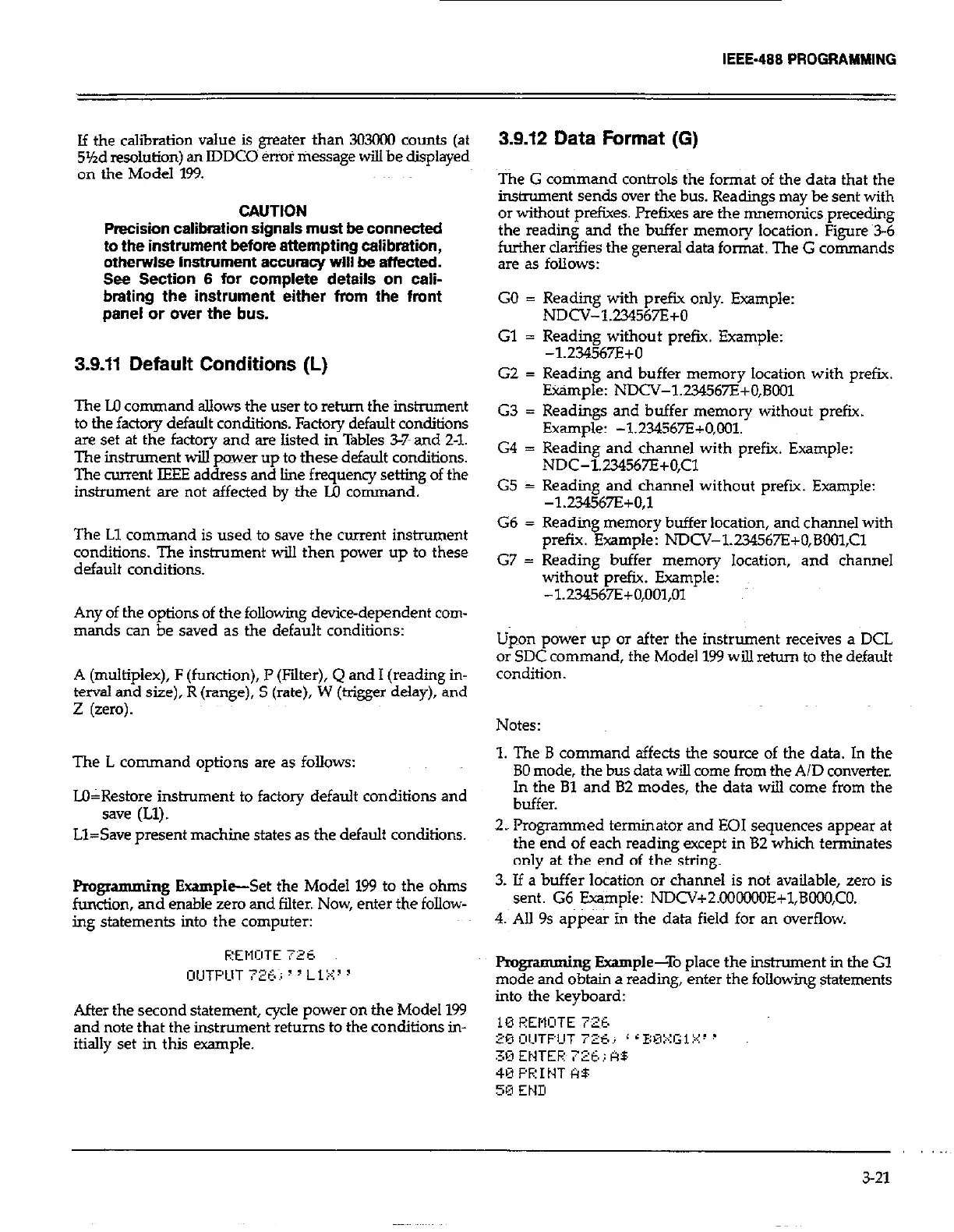IEEE-488 PROGRAMMING
If the calibration value is greater than 303000 counts (at
5’hd resolution) an IDDCO ermr message will be displayed
on the Model 199.
CAUTION
Precision calibration signals must be connected
to the instrument before attempting calibration,
othewise instrument accuracy will be affected.
See Section 6 for complete details on cali-
brating the instrument either from the front
panel or over the bus.
3.9.11 Default Conditions (L)
The I.0 command allows the user to return the instrument
to the factory default conditions. Factory default conditions
are set at the factory and are listed in Tables 3-7 and 2-l.
The instrument will power up to these default conditions.
The went IEEE address and line frequency setting of the
instrument are not affected by the LO command.
The Ll command is used to save the current instrument
conditions. The instrument will then power up to these
default conditions.
Any of the options of the following device-dependent com-
mands can be saved as the default conditions:
A (multiplex), F (function), P (Filter), Q and I (reading in-
terval and size), R (range), S (rate), W (trigger delay), and
z (zero).
The L command options are as follows:
J&Restore instrument to factory default conditions and
save (Ll).
Ll=Save present machine states as the default conditions.
Programming Example-Set the Model 199 to the ohms
function, and enable zero and filter. Now, enter the follow-
ing statements into the computer:
After the second statement, cycle power on the Model 199
and note that the instrument returns to the conditions in-
itially set in this example.
3.9.12 Data Format (G)
The G command controls the format of the data that the
instrument sends over the bus. Readings may be sent with
or without prefixes. I’refixes are the mnemonics preceding
the reading and the buffer memory location. Figure 3-6
further clarifies the general data format. The G commands
are a5 follows:
GO = Reading with prefw only. Example:
NDCV-1234567E+O
Gl = Reading without prefix. Example:
-1.234567EtO
G2 = Reading and buffer memory location with prefix.
Etimple: NDCV-1234567E+O,BOOl
G3 = Readings and buffer memory without prefix.
Example: -1.234567E+O,oOl.
G4 = Reading and channel with prefix. Example:
NDC-1234567E+O,Cl
G5 = Reading and channel without prefix. Example:
-1.234567EeO.l
G6 = Reading memory buffer location, and channel with
prefix. Example: NDCV-1.234567E+O,BOOl,Cl
G7 = Reading buffer memory location, and channel
without prefix. Example:
-1.234567E+O,OOl,Ol
Upon power up or after the instrument receives a DCL
or SDC command, the Model 199 wiJ.l return to the default
condition.
Notes:
1. The B command affects the source of the data. In the
BO mode, the bus data wilI come from the A/D converter.
In the Bl and B2 modes, the data will come from the
buffer.
2. Programmed terminator and EOI sequences appear at
the end of each reading except in 82 which terminates
only at the end of the string.
3. If a buffer location or channel is not available, zero is
sent. G6 Ewinple: NLKV+2.000lOOE+1,8000,C0.
4. All 9s appear in the data field for an overflow.
Programming Example-To place the in&ument in the Gl
mode and obtain a reading, enter the following statements
into the keyboard:
3-21

